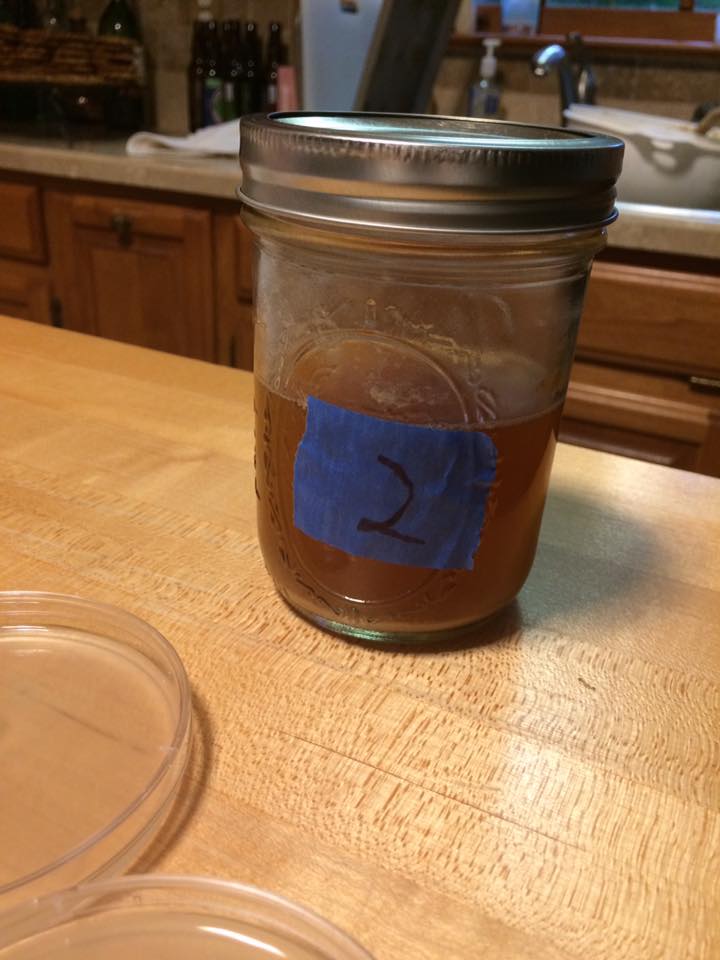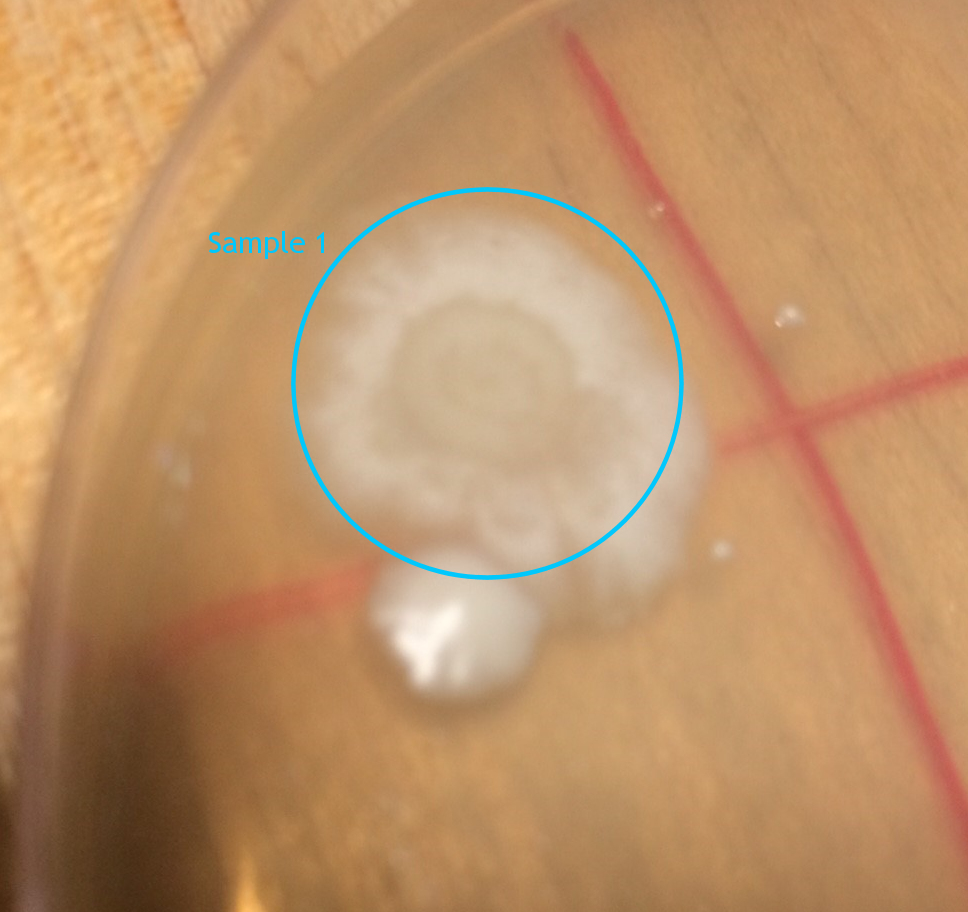Our Story
Our Story
Shoe Brewing Company was born sometime between 1980 and 2016. During this time a love of science, cooking, and of course beer, resulted in the crafting of "Ein", Shoe Brewing Company's first concoction. The story continues now with experimentation with process and ingredients to approach perfection of the craft. In the end, we hope you will discover, as we have, that you want our brew in your mouth.
Wild Yeast Experiment
We recently set out to capture a wild strain of yeast to use in a future recipe. The process began with
preparing a small batch of wort and placing about 300ml of wort in four wide-mouth canning jar collectors.

Then we capped each collector with cheese cloth and screwed on the lid.

Collector #1 went in the front yard, in #2 I place a piece of bark from an oak tree in my back yard,
#3 in the back yard, and #4 near some fruit on my countertop, .

We also had to create some agar plates so we could eventually isolate any yeast we captured...our first
attempt at creating plates did not go well. You can't really tell from the image but the plates had too
much water and several of the plates indicated contamination after a couple of days.

We let the collectors sit out over night and then put them in a warm dark place for a few days. After a
few days the only jar that looked like it may have yeast was #2 with the oak bark. The others had all sorts
of stuff growing in them but no evidence of fermentation. We tossed the contents from #1, #3, and #4 down the
sink. #2 appeared to have some bubbles formed, and also smelled of alcohol...good signs. It also had a strong
apple smell. We wanted to taste the sample, but without definative proof of fermentation, it wasn't a good
idea.

We prepared some new agar plates, which came out much better, and began the process to isolate the yeast.
We bought some equipment from Carolina Biological Supply to
increase our chance of success: an alcohol lamp for sterilization, a wire inoculation loop, a test tube rack
(for use later), and some more agar plates.

After sterilizing the wand and swirling the wand in the oak bark sample we inoculated a couple of agar
plates. One plate had a sample from the liquid, the other had a sample from the bottom of the jar.

After a couple of days we had some good growth...of something. We had a least two distinct growths on the
plate.

Now we needed to take samples of the two isolated colonies and see if we definately had yeast. We created
3 jars, much like the collection jars, but this time we topped them with airlocks
we purchased online through Amazon. The wort for these samples had an original gravity of 1.054...this would
potentially produce beer at approximatley 5.11% ABV provided all the sugar was consumed by the yeast. We used this
measure hoping 5% ABV would kill anything else that may be growing in the jar. Thinking about this, the fact
that only two things survived the initial oak bark jar may indicate we truly only have yeast, and perhaps two
different strains. Jar #1 had a sample of growth, the morphology of which, looked kinda round and fuzzy. #2
had a sample of growth that had a morphology that was also round, but smoother and shiny. #3 had a sample of
growth that looked much like #1 but not as uniform in it's roundness. We sanitized the inoculation loop between
scraping a sample of each growth and swirling it around in a jar (labled 1, 2, and 3). You can see a couple of
the agar plates from the first attempt with mold (and other) contamination at the bottom of the image...I kept them
to see what would grow...pretty gross.





Sample #2 was the first to show signs of fermentation and it seemed pretty vigorous. After #2 looked like
it completed fermentation we began to see signs of fermentation in sample #3. This may indicate two differnt
types of yeast or #3 may have been contaminated with some of #2.

Then sample #1 also began to ferment. We didn't know what to think at this point. Again, we could have two
different strains of yeast, or there was some contamination.

We took a good look at sample #1 after several more days of growth and it still looks like a pure colony
(although now it has grown closer to a colony of #2).

A closer inspection of the plate with #2 and #3 shows that #3 may have been contaminated. The arrow shows
where a colony of #2 may have been growing under #3.

Once the jars are done fermenting we'll take some gravity measurements and do some tasting...stay tuned!
Well for some reason sample #2 may have started fermenting again. Based on some research it could just be
CO2 being released from the solution...common in beer brewing, but I wouldn't expect much from such a small
batch.

Today we decided to do a gravity test and also repeat the agar plate test to see if we successfully isolated
a yeast strain (or two).

The hydrometer indicated 1.040 which calculates out to approx. 1.84% alcohol. We were going to taste it
but thought it would be better to wait and see if the ABV would rise to at least 4% before we taste. There's
enough sugar to get it to 5%...not sure if wild yeast tops out.

To repeat the agar test we tried to ensure we were as sterile as possible between each touch of the agar
plate.

This is sample #1. Obvious evidence of fermentation and it also had a strong apple smell. We could smell
alcohol in sample #2 but it just smelled sweet...no apple smell. This is good evidence we actually may have
isolated two different wild yeast strains! Also, according to Virginia Beer Company's
website, "Brettanomyces (a family of "wild" yeast strains) fermentations will often grow a pellicle (especially in
the presence of oxygen)" as seen in the photo below. Click the link to see a very similar photo. So until we find
more convincing evidence to the contrary, we're assuming this is a strain of brettanomyces.

This is sample #3. This also had an apple smell but not as strong...kind of a mix of #1 and #2. This
supports our ealier speculation that sample #3 may have been contaminated with some #2.

We created a new agar plate for each sample. Prediction: #1 will only grow the round, off-white and fuzzy
yeast, #2 will only grow the round, off-white and smooth/shiny yeast, and #3 will have both.

OK...it's been four days, we have good yeast growth, AND our prediction was correct. Sample #1 is a pure
isolated sample with the round fuzzy yeast. This sample had a very strong apple smell.

Sample #2 is a pure isolated sample of a differnent strain. This one is round, smooth, and shiny and has
a sweet and funky smell.

Sample #3 is indeed a mix of both. This one had an apple smell as well but not quite as strong.

We did some research and found that wild yeast may top out at 2-3% alcohol. Many brewers will start with a
wild yeast and then add a brewers yeast to complete the fermentation. We're going to let our samples continue to ferment
for a couple of more weeks before doing another gravity test (and perhaps taste test).
OK, a couple of weeks have passed and there's been some interesting activity. All three samples continued to
ferment, but we still don't feel safe tasting. Also, for some reason, the sanitizer in the airlocks got sucked into the
jars and we're not sure what that may have done to the samples. So we decided to make another batch of wort (OG was 1.051)
and build up more of the yeast. We're going to use samples #1 and #2 since they were pure and let them ferment for 2 weeks
and then take a gravity reading. We used "S" type airlocks this time to avoid getting the sanitizer sucked into the samples.
If the gravity check doesn't indicate a full fermentation we'll let it go another week, and if still not done, we're
going to add regular brewers yeast to finish it up.

In order to move along on the project we decided we needed some equipment to aid in the isolation/identification of
our yeast. So, we bought this microscope from AmScope. Here's what we found.

This is a short video of Sample #1. There are at least two distinct
(I think) types of microorganism here and we haven't seen any other pictures like this. Here is a short video of Sample #2.
This has only one (I think) type of microorganism and consistent with other pictures I've seen of brewers yeast (on the left hand side
you can see a bud formed on the mother cell).
It's been about a month and a half since putting the yeast in fresh samples. We took a gravity reading on Sample #1 and
there was virtually no change in the gravity. Additionally a large slimy mass formed in the jar and under the microscope the enlongated
cells are much longer. We are beginning to doubt this is a yeast but more likely a bacteria. The smaller cells with the distinct
nuclei remained the same (the jury is still out on these but with no fermentation it's likely not yeast). We're going to try an agar plate
one more time on Sample #1. The gravity of Sample #2 dropped to 1.020
(OG was 1.051). Based on the ABV calculator
our sample is at 4.07% alcohol. We decided that was good enough and went ahead and had a VERY small taste. It was not offensive
and a little funky. We're comfortable calling Sample #2 a wild saccharomyces due to the change in gravity, visible evidence of active
fermentation (bubbles), the microscopic evidence and some online research. World, prepare yourselves for a beer brewed with this yeast!
Stay tuned for more!